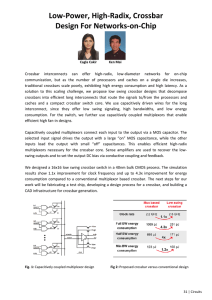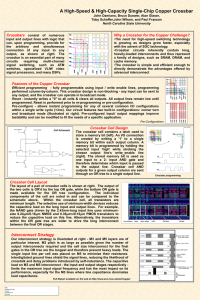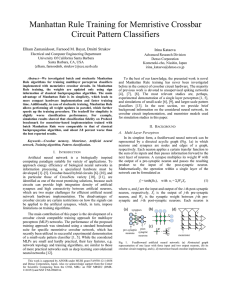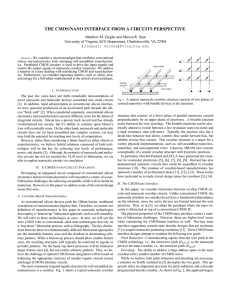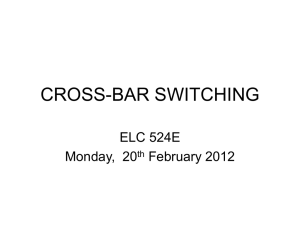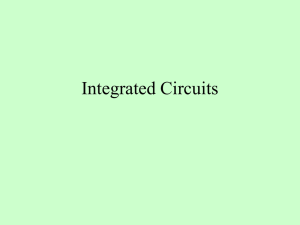slides from group 2
advertisement
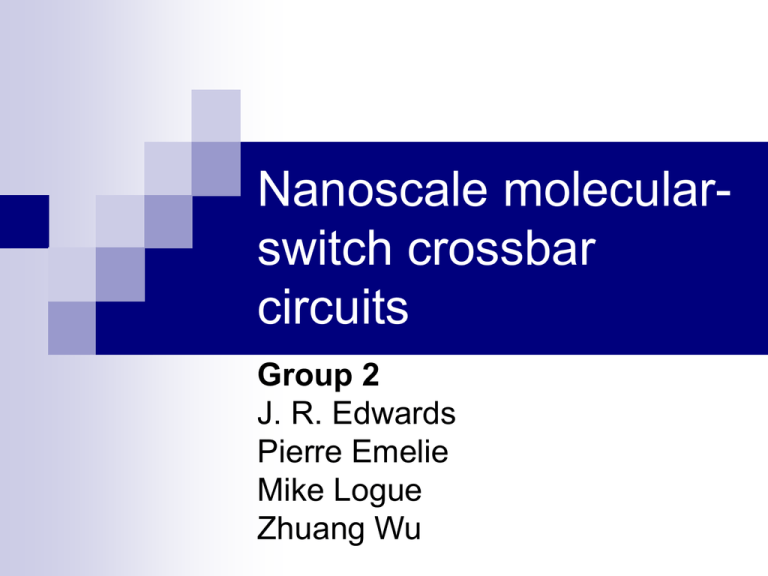
Nanoscale molecularswitch crossbar circuits Group 2 J. R. Edwards Pierre Emelie Mike Logue Zhuang Wu Outline Introduction and basic principles of crossbar circuits Growth techniques Current research results Summary Introduction Nearly a billion transistors on a silicon chip Lengths of the smallest chip will shrink to nearly the molecular scale Major innovations are needed to reach a length for functional features around 10 nm (30 atoms long) Quantum Computing A classical computer has a memory made up of bits A quantum computer maintains a set of qubits and operates by manipulating them A qubit can hold a “1”, a “0” or a superposition of these Qubits can be implemented using the two spin states of an electron If large-scale quantum computers can be built, they will be able to solve certain problems faster than any classical computer It is however decades away from realization It remains unclear how useful it would be for most applications Several groups are investigating another path (one group at the Hewlett-Packard Laboratories was the precursor) The crossbar architecture Crossbar Architecture Configurable crossbar architecture Array of crossing nanowires Switch is formed at the junction between two crossing nanowires Nanowires are separated by a single monolayer of molecules Crossbar Architecture High resistance state “OFF” state Low resistance state “ON” state VT=0.2 V Voltage limit |VT|<2 V The switch remains in the state it was last set Positive (negative) cycling voltages reversibly switch the device to the “ON” (“OFF”) state Crossbar Architecture “OFF” state (ohmic response) Rd=9.2x106 Ω VT=0.2 V Curves are offset for clarity “ON” state (ohmic response) Clockwise IV hysteresis Rd=4.8x105 Ω Counter-clockwise IV hysteresis “OFF” state (ohmic response) Rd=8.1x106 Ω Crossbar Architecture Molecular structure of the bistable [2]rotaxane R Imprint lithography is used to grow these molecular-switch devices Crossbar Architecture How do we control these crossbars and link them with external systems in order to perform memory and/or logic functions? By using micron-scale silicon ICs How do we bridge the gaps in size and number of wires between nanoelectronics and the conventional-scale silicon ICs? => By using a demultiplexer Demultiplexer Demultiplexer enables conventional wires on silicon chips to control a great number of nanowires If k is the number of conventional wires, the multiplexer can control 2k nanowires An additional d conventional wires provide redundancy to work despite broken connections Applications and Advantages This configurable architecture can be used to perform memory and/or logic function The wires can be scales continuously down to molecular sizes while the number of wires in the crossbar can be scaled up arbitrarily to form large-scale generic circuits It requires only 2N communication wires to address 2N nanowires This allows the nano-circuit to communicate efficiently with external circuits It can tolerate defective elements generated during the fabrication process by introducing redundancy Fabrication is feasible and potentially inexpensive Next: More details on the fabrication process and some results will be presented Fabrication Overview Pattern bottom electrode and deposit rotaxane monolayer switching material Protective Ti layer evaporated onto film Pattern top electrode Remove excess Why Nanoimprint Lithography Pattern small feature sizes High throughput Low cost Precludes damage to sensitive components Nanoimprint Lithography (NIL) But at smaller feature sizes, resist adheres to mold. Double-layer UV-curable NIL Double-layer UV-curable resist Highly cross-linked top imaging layer, mechanically strong Bottom transfer layer with good liftoff, also serves to planarize the surface Exceptional thickness uniformity Thickness distribution of spin-coated UV-curable imprint resist over a 4 inch wafer. Double-layer UV-curable NIL The Mold Build out of silicon substrate using e-beam and optical lithography Benefits Hundreds of circuit patterns per mold: increases throughput because large number of circuits created with one imprinting step Reusable: reduces costs Mechanical mechanism precludes damage Double-layer UV-curable NIL Imprint and Curing Mold pressed onto resist layer with homogeneous pressure (500psi) Heated to 80 C to cross-link imaging layer Double-layer UV-curable NIL Reactive Ion Etching (RIE) Etch down to substrate layer Oxygen RIE Selectivity of greater than 10 between imaging and transfer layer---gives margin in over-etching RIE Reactive gas and accelerated ions increase etch rate Etch product may form passivation layer on the side wall---preventing lateral etching. Anisotropic Double-layer UV-curable NIL Metal and Liftoff Metal (Ti and Au, Pt) evaporated onto pattern Solubility of transfer layer provides good liftoff of resist Wetting problem Adhesion and Wetting Hydrophobic imaging layer reduces adhesion forces between mold and resist but also prevents solvent from getting into the feature gaps Solution: treat the surface with O2 plasma to improve wetting property of the resist. Nanoscale cross-bar circuits Write a bit A positive voltage ranging from 3.5 to 7 V would turn it ‘on’, and a negative voltage ranging from −3.5 to −7 V would switch it ‘off’. A voltage bias |V| < 3.5 V applied to the devices did not change their resistance state 1) 2) 3) 4) “0”---- 106—5X108Ω “1”---- 4X109Ω and up Write at the cross point Keep the voltage at other cross points so that the error rate is reduced Read a bit a bias voltage (much smaller than the voltage used to write the bit) was applied across the row and column of the bit to be read (e.g. row A and column 1 for reading cross point (1, A) in figure 3(a)), but all of the other rows and columns were grounded. Resistivity Reading current Max reading current is of the order of 10-10A Results for 1kbits memory circuits More condensed nanowires Read current Electronic characteristics it shows the process of turning on and off. the turning on and off processes don’t overlap with each other. Limitations The current crossbar memory technology does not allow for a very large number of write cycles A voltage magnitude, |V| >=3.5 is needed to change the resistance state between ‘0’ and ‘1’ Lithography used in electrode and connection fabrication Nanowires are so small that atomic defects are unavoidable and serious Limitations Resolution is limited currently to about 30nm half-pitch Have to build in redundancy to compensate for defects Range of logic operations that can be performed is limited without the NOT function Conclusions Nanoscale crossbar structures show potential in developing new nanoelectronics, especially high density memory and logic It will take many years before the manufacturing technology reaches the point where the full potential of these structures can be realized Future Work Defect Tolerance Improvement of nanofabrication technology for more reliable, higher density crossbar structures Look at what materials are best suited for these structures Increase logic capabilities of the crossbar structure Summary Nanoscale molecular crossbar circuits can function as ultra high density memory Demultiplexer/multiplexer logic can be integrated with the memory using the crossbar structure There is a lot of interest in the use of nanoscale crossbar structures for use in high density nanoelectronics More work has to be done to achieve full potential of the crossbar structure
